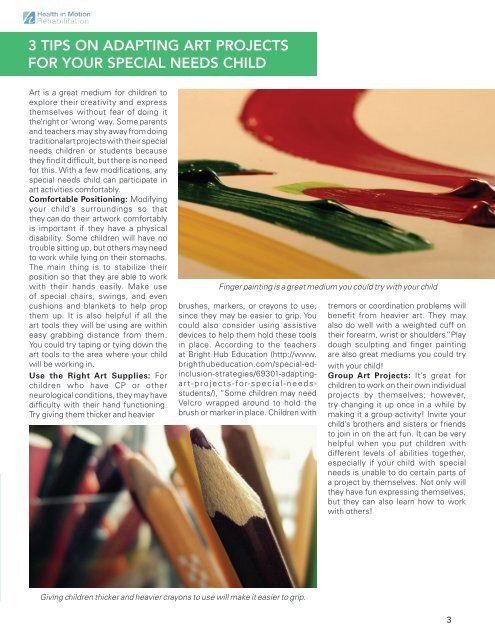Create successful ePaper yourself
Turn your PDF publications into a flip-book with our unique Google optimized e-Paper software.
3 TIPS ON ADAPTING ART PROJECTS<br />
FOR YOUR SPECIAL NEEDS CHILD<br />
Art is a great medium for children to<br />
explore their creativity and express<br />
themselves without fear of doing it<br />
the ‘right or ‘wrong’ way. Some parents<br />
and teachers may shy away from doing<br />
traditional art projects with their special<br />
needs children or students because<br />
they find it difficult, but there is no need<br />
for this. With a few modifications, any<br />
special needs child can participate in<br />
art activities comfortably.<br />
Comfortable Positioning: Modifying<br />
your child’s surroundings so that<br />
they can do their artwork comfortably<br />
is important if they have a physical<br />
disability. Some children will have no<br />
trouble sitting up, but others may need<br />
to work while lying on their stomachs.<br />
The main thing is to stabilize their<br />
position so that they are able to work<br />
with their hands easily. Make use<br />
of special chairs, swings, and even<br />
cushions and blankets to help prop<br />
them up. It is also helpful if all the<br />
art tools they will be using are within<br />
easy grabbing distance from them.<br />
You could try taping or tying down the<br />
art tools to the area where your child<br />
will be working in.<br />
Use the Right Art Supplies: For<br />
children who have CP or other<br />
neurological conditions, they may have<br />
difficulty with their hand functioning.<br />
Try giving them thicker and heavier<br />
Finger painting is a great medium you could try with your child<br />
brushes, markers, or crayons to use,<br />
since they may be easier to grip. You<br />
could also consider using assistive<br />
devices to help them hold these tools<br />
in place. According to the teachers<br />
at Bright Hub Education (http://www.<br />
brighthubeducation.com/special-edinclusion-strategies/69301-adaptingart-projects-for-special-needsstudents/),<br />
“Some children may need<br />
Velcro wrapped around to hold the<br />
brush or marker in place. Children with<br />
tremors or coordination problems will<br />
benefit from heavier art. They may<br />
also do well with a weighted cuff on<br />
their forearm, wrist or shoulders.”Play<br />
dough sculpting and finger painting<br />
are also great mediums you could try<br />
with your child!<br />
Group Art Projects: It’s great for<br />
children to work on their own individual<br />
projects by themselves; however,<br />
try changing it up once in a while by<br />
making it a group activity! Invite your<br />
child’s brothers and sisters or friends<br />
to join in on the art fun. It can be very<br />
helpful when you put children with<br />
different levels of abilities together,<br />
especially if your child with special<br />
needs is unable to do certain parts of<br />
a project by themselves. Not only will<br />
they have fun expressing themselves,<br />
but they can also learn how to work<br />
with others!<br />
Giving children thicker and heavier crayons to use will make it easier to grip.<br />
3










